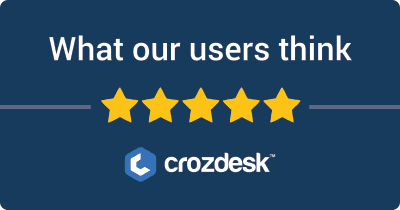
In the realm of outbound software, "Groove" and "SalesHandy" stand out as two popular tools designed to enhance sales outreach and improve email tracking. Both platforms are tailored for sales professionals seeking to optimize their workflows, engage prospects more effectively, and ultimately drive revenue. Users are often drawn to these tools due to their distinct features aimed at streamlining communication and tracking engagement in real-time.
Groove is primarily focused on augmenting Salesforce with robust sales productivity features, while SalesHandy emphasizes email tracking, document sharing, and recipient engagement analytics. When considering these tools, users typically evaluate several key aspects including:
- Features: What capabilities do each tool offer in terms of email automation, analytics, and integrations?
- Pricing: How do the costs compare, and which tool provides better value based on its feature set?
- Ease of Use: How user-friendly is each platform, especially for teams with varying levels of tech proficiency?
- Integrations: How well do they integrate with existing CRM and other productivity tools?
By comparing these aspects, users can make informed decisions based on their specific outbound sales needs.
Groove VS SalesHandy: Which tool is the most popular?
| Tool | Number of Reviews | Average Rating | Positive Reviews | Neutral Reviews | Negative Reviews |
|---|---|---|---|---|---|
| Groove | 20 | 4.75 | 19 | 0 | 1 |
| SalesHandy | 20 | 2.9 | 10 | 0 | 10 |
Groove is the most popular tool based on a high average rating of 4.75 from 20 reviews, with 19 positive reviews and only 1 negative feedback. In contrast, SalesHandy is the least popular, receiving an average rating of 2.9, with an equal number of 20 reviews but a significant ratio of negative feedback—10 negative reviews and only 10 positive.


Groove and SalesHandy: Quick Comparison Overview
| Feature/Aspect | Ahrefs | SEMrush |
|---|---|---|
| Primary Features | – Site Explorer – Keyword Explorer – Backlink Checker – Content Explorer – Rank Tracker |
– Keyword Research – Site Audit – Position Tracking – Content Analyzer – Marketing Insights |
| Target Audience | – SEO professionals – Digital marketers – Agencies focusing on content marketing and backlink analysis |
– Digital marketers – SEO experts – Content marketers – Social media marketers and PPC specialists |
| Main Advantages | – Robust backlink analysis – Comprehensive keyword data – Intuitive user interface – Constantly updated index |
– All-in-one digital marketing tool – Extensive competitor analysis – Wide array of tools for SEO and PPC – Integrated social media management |
| Core Value Proposition | Focused on providing in-depth SEO insights, particularly strengths in backlink profiles and organic keyword rankings. Ideal for users prioritizing content strategy and link-building efforts. | Offers a holistic view of digital marketing, making it easier to manage all aspects of online presence through an extensive range of tools for SEO, PPC, and social media marketing. |
| Ideal Use Cases | – Conducting comprehensive link audits – Developing effective content strategies – Tracking backlinks and organic rankings – Keyword planning for SEO campaigns |
– Managing and optimizing PPC campaigns – Conducting competitive analysis for market positioning – Comprehensive content analytics and SEO tracking – Social media metrics and management |
Most liked vs most disliked features of Groove and SalesHandy
| Feature | Groove | SalesHandy |
|---|---|---|
| Most Liked Features | – Ease of monitoring emails and efficient search capabilities. | – User-friendly interface and ease of setup. |
| – User-friendly for transitioning from platforms like Outlook. | – Strong performance in email marketing and tracking. | |
| – Read receipts and internal communication post-it notes. | – Wide array of features for sales outreach. | |
| – Prompt and effective customer support. | – Professional and helpful support team. | |
| – Centralized management of customer support tickets. | – Customizable to meet organizational needs. | |
| – Efficient lead management and data storage. | ||
| Most Disliked Features | – Time-consuming setup and customization process. | – Limited file type compatibility (only CSV). |
| – Inability to reply to earlier email threads. | – Missing desirable features in the base package. | |
| – Potential integration challenges for new users. | – Complicated workflows needing simplification. | |
| – Learning curve for users transitioning from other platforms. | – Reported bugs affecting user experience. | |
| – Customization can create challenges for specific needs. | – Certain functionalities not performing as expected. |
Key Features of Groove vs SalesHandy
Certainly! Here’s a comparison of key features of "Groove" and "SalesHandy" for outbound software, along with a description of how each feature benefits users and any unique aspects that each brand offers.
Groove
-
Email Tracking
- Benefit: Users can track email opens and link clicks in real-time, allowing sales teams to know when their emails have engaged leads.
- Unique Aspect: Provides detailed insights and analytics on email performance, helping teams refine their outreach strategies.
-
Sales Cadences
- Benefit: Users can create and manage multi-step outreach sequences across various channels. This structure ensures consistent follow-up with potential leads.
- Unique Aspect: Groove’s integration with CRM systems allows sales representatives to automate these cadences directly from their work environment, enhancing usability.
-
Integration with CRMs
- Benefit: Seamless synchronization with CRMs ensures that all data is consistent and accessible, simplifying tracking and reporting.
- Unique Aspect: Groove’s integration capabilities extend beyond emails to include calendar scheduling, enabling a more comprehensive sales workflow.
-
Analytics & Reporting
- Benefit: Provides detailed reporting on team performance and outreach effectiveness, allowing for ongoing optimization of strategies.
- Unique Aspect: Offers customizable reporting tools that can be tailored to specific metrics or KPIs, making it easier for users to focus on what matters most.
-
Workflow Automation
- Benefit: Automates repetitive tasks, allowing sales teams to focus more on selling rather than administrative work.
- Unique Aspect: Groove offers personalized workflow automation, which can adapt to individual user behaviors or preferences.
-
Gmail/Outlook Integration
- Benefit: Instant access to Groove’s features directly in familiar email platforms enhances user experience and reduces the learning curve.
- Unique Aspect: This deep integration allows for smooth transitions between email and CRM systems without switching tabs or platforms.
SalesHandy
-
Email Tracking
- Benefit: Similar to Groove, SalesHandy provides real-time tracking for emails, helping users determine the effectiveness of their outreach.
- Unique Aspect: Offers insight into recipient engagement with documents and presentations attached, which is a bonus for teams sharing detailed collateral.
-
Document Tracking
- Benefit: Users can track how much time recipients spend on specific documents, aiding in understanding which materials resonate most.
- Unique Aspect: This feature allows for more informed follow-up conversations, providing context based on recipient interest.
-
Email Campaigns
- Benefit: SalesHandy empowers users to create and manage mass email campaigns with personalized touches, making outreach scalable while maintaining a personal feel.
- Unique Aspect: The platform allows A/B testing of email campaigns, giving users insights into what messaging works best before rolling out broader campaigns.
-
Mailbox Sharing
- Benefit: Teams can collaborate on outbound efforts by sharing email accounts, which can streamline communication and ensure consistent messaging.
- Unique Aspect: This feature enhances team collaboration and transparency, allowing multiple team members to access and manage the same mailboxes.
-
Scheduling
- Benefit: The email scheduling feature allows users to send emails at optimal times. This increases the likelihood of recipient engagement.
- Unique Aspect: SalesHandy includes a shared calendar feature that aids teams in coordinating schedules for outreach effectively.
-
Templates
- Benefit: Users can create and store email templates for quick access, improving efficiency in email composition.
- Unique Aspect: The AI-driven suggestions for subject lines and content based on previous successful emails stand out as a unique enhancement to user experience.
Conclusion
Both Groove and SalesHandy bring powerful features to the table for outbound software, each with its own unique aspects. Groove tends to focus on seamless CRM integration and personalized automation, making it ideal for teams that rely heavily on a structured workflow. Meanwhile, SalesHandy emphasizes document tracking and easy mass-email management, making it suitable for teams that need extensive outreach capabilities with a strong emphasis on content engagement.
Depending on a company’s specific needs, either tool can offer substantial benefits to optimize and streamline outbound sales efforts.
Groove vs SalesHandy Pricing Comparison
| Feature/Plan | Groove Pricing | SalesHandy Pricing |
|---|---|---|
| Free Trial | 14-day free trial | 14-day free trial |
| Monthly Subscription | Starting at $12/user/month | Starting at $9/user/month |
| Annual Subscription | Starting at $10/user/month (billed annually) | Starting at $7/user/month (billed annually) |
| Basic Tier | $12/user/month | $9/user/month |
| – Features Included | Email management, team inbox, basic automation | Mail tracking, template creation, document tracking |
| Professional Tier | $24/user/month | $13/user/month |
| – Features Included | Advanced reporting, integrations, and automation | Advanced analytics, follow-up reminders, and more templates |
| Enterprise Tier | Custom pricing | $28/user/month |
| – Features Included | Custom features, dedicated account manager, enterprise-level security | Advanced team management, priority support |
| Discounts | 20% off annual subscription | 20% off annual subscription |
| Key Differences | – Focus on email collaboration and robust team features | – Emphasis on email tracking and engagement analytics |
| – Includes features like a team inbox and custom automation tools | – Features more in-depth tracking tools and analytics dashboards |
This table summarizes the pricing structures for Groove and SalesHandy, highlighting their monthly and annual rates, feature differences by tier, and available discounts.
Support Options Comparison: Groove vs SalesHandy
| Support Features | Groove | SalesHandy |
|---|---|---|
| Live Chat | Available during business hours, direct access to support agents. | Live chat support is available for immediate assistance. |
| Phone Support | No phone support option. | Offers phone support for direct communication. |
| Documentation | Comprehensive knowledge base with articles and FAQs. | Robust documentation available, including detailed user guides. |
| Webinars/Tutorials | Periodic webinars and video tutorials available for training. | Offers resources such as tutorials and webinars to enhance user knowledge. |
Conclusion: Groove provides an accessible live chat option and a thorough documentation resource, but lacks phone support. SalesHandy, conversely, offers phone support alongside live chat, and also features a strong library of documentation and additional resources like tutorials and webinars for user learning.
Unique Features of Groove Vs SalesHandy
| Feature | Groove | SalesHandy | Unique Value Proposition |
|---|---|---|---|
| Workflow Automation | Seamless integration with Salesforce CRM, providing automated task management tailored for sales processes. | Real-time tracking of emails and templates usage, enabling metrics-driven adjustments to outreach strategies. | Groove’s deep CRM integration ensures that sales reps spend less time on administrative tasks, thus allowing more focus on selling. |
| Communication Insights | Advanced analytics on email and call activities, including sentiment analysis and interaction patterns. | Comprehensive document tracking, with engagement metrics for shared documents. | Groove’s insights help sales teams refine their communication strategies and prioritize leads based on engagement metrics. |
| Omnichannel Engagement | Supports calls, emails, and meetings within a single platform, facilitating a unified sales approach. | Primarily email-focused with templates and tracking features. | Groove’s omnichannel feature promotes a more holistic approach to sales, making it easier to coordinate efforts across mediums. |
| Personalization Tools | AI-driven suggestions for personalized communication based on prospect data. | Customizable email templates and schedules. | Groove’s personalization tools enhance engagement potential by leveraging data to create tailored messaging for each prospect. |
| Integration Options | Extensive app integrations beyond CRM, such as Slack and Zoom, for improved collaboration. | Limited integration options mostly around email and basic CRM functionalities. | Groove’s extensive integrations foster collaboration and increase productivity by connecting various tools used by sales teams. |
| Interactive Engagement | In-app task assignment and collaboration on deals, allowing team members to work together directly on the platform. | Basic collaboration tools, lacking real-time deal updates. | Groove’s team collaboration features enhance teamwork and speed up the sales cycle by allowing real-time contributions and updates. |
The unique features offered by Groove and SalesHandy provide distinct advantages compared to standard outbound software. Groove’s advanced integration and productivity features streamline sales processes, allowing teams to focus their efforts on relationship-building rather than administrative tasks. SalesHandy offers innovative document tracking that helps sales teams optimize their outreach based on real-time data. These features are deciding factors for users seeking enhanced productivity, effective communication, and collaborative sales strategies in today’s fast-paced sales environment.


